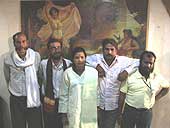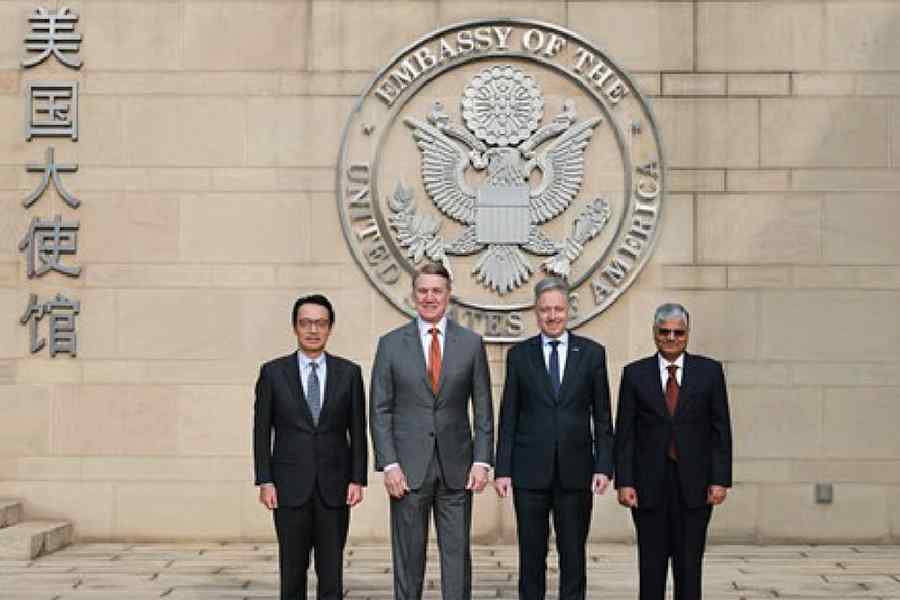 |
| ACTION TO ACTING: Seema Parihar with the crew of Wounded in Lucknow last month (PTI) |
Twelve-year-old girl artiste Aditi Pandey steps out of a hut. The character she plays has just been raped and brutalised by her 54-year-old husband, Fakkad Baba. The camera pans from the miles of sandy ridges and twisting fissures in the distance, onto the conical thatched roofs of villagers in a hamlet near the Chambal ravines, and finally closes in on the grim face of the traumatised child-woman. The director, Krishna Mishra, calls for a freeze. The camera whirrs to a halt.
Among the crowd that has assembled around the film unit is the real-life heroine of the movie being made on her life, ex-bandit Seema Parihar. She is weeping.
“It is agonising to watch a replay of what happened to me 20 years ago,” says the tall, somewhat severe-looking 32-year-old who plays herself in the film. The life of the new Phoolan Devi bears an uncanny resemblance to the old. And the movie recounting it, Wounded, will inevitably be compared to Shekhar Kapur’s Bandit Queen.
If all goes well the film may change the course of Seema Parihar’s life for ever. Born in Babian village in Etawah district of Uttar Pradesh, she was forced to marry a man older than her. “My father had a running battle with a Gujjar over land,” she tells you. “The Gujjars in my village, who were powerful, got a dacoit to abduct me. First, the 53-year-old dacoit Lala Ram raped me repeatedly, then forced me to marry Fakkad Baba, another veteran dacoit 22 years older than me.” Thus began the chain of sequences that led to her finally taking over control of a dreaded gang of dacoits. “You have to understand,” she says, reasoning closely. “No woman would want to turn outlaw unless she became a victim of the bandit cycle.”
Like Phoolan Devi, who married Malkhan and then Man Singh before she raised her own gang to take revenge in Behmai, Seema Parihar took up with Nirbhay Gujjar after Lalaram and Fakkad Baba were killed in an encounter. Nirbhay Gujjar, who taught Seema how to use a gun and familiarised her with the rugged terrain of the ravines, was also killed, but not before fathering her son. After Gujjar’s death, Seema took over the reins of the gang, and let loose a reign of terror. Everyone, from Bhind, Morena in Madhya Pradesh to Etawah, Agra and Kanpur, knew her name. During the 18 years of her rule in the ravines , she is believed to have killed 70 persons, looted 30 houses and abducted 200 persons to demand ransom till she surrendered before the Kanpur police in 2003. She was facing 29 cases out of which 15 cases have already been dropped. Hers was, interestingly, one of the 10 dacoit gangs in the area led by women, almost all of them victims of abduction.
Ashoke Singh Bhadoria, who heads the anti-dacoit wing of the local police, recalls : “Seema Parihar is the most dreaded dacoit, but beautiful — in a way — and glamorous too. She likes the best salwar-kameezes. She developed a taste for foreign perfumes.” She also enjoyed movies. “I loved watching movies on the VCR, especially old action thrillers like Kachche Dhaage,” says the woman who is remembered to have whistled cheerful film tunes while cleaning her gun.
She’d never dreamt, however, that she would one day act in an action thriller of her own. When the film unit from Mumbai was looking for a “more realistic movie on the ravines than ever made before,” Seema Parihar thought she’d spotted a career break. And this was when she made her daring offer to the director: to act out her own story. “Aap mujhe mauka kyon nahin dete? (Why don’t you give me a chance?)” Mishra remembers her asking. It obviously took time for the film unit to say yes to this bandit queen. But now, after four months of work on the script, and 60 per cent of the film complete, the director exudes confidence. “She faced many bullets from the police. She tackled them well. Now, she is facing the camera with equal ease,” says Mishra. Wounded, made at the modest cost of Rs 1.25 crore, is being produced by first-time producers Shalini and Chanda.
If anyone is wary of the direction the film will take, it is Seema Parihar herself. “You show women dacoits nude in films,” she told the unit team sternly in a clear reference to the fate of Phoolan Devi. “I don’t want to involve myself in a dirty film. If you want to make a film on what I have gone through, then it is okay.” When the film was first initiated, the project got suspended for a while as Seema declined to do some scenes requiring some exposure. “Even after I decided to cut down on some of those scenes, it took me more than a year to convince her that without a few of those scenes, her real life story could get weakened,” said Mishra.
There is another side to this woman. She is passionately devoted to her son. “When she was still a dacoit in hiding, she would meet him in private at the residence of her brother Ram Kumar Singh where he is being brought up. No fellow dacoit had permission to accompany her for she always wanted to shield him from any connection with the gang. She would dote over him during the hours she would spend with him,” says a member of the film unit who interviewed her associates.
And then there is the dark side. In her fouler moods, her brutality surpassed all others’ records. According to one police officer based in Madhya Pradesh, Seema had a twisted, complex relationship with men. Hating them one moment for the indignities some had perpetrated on her, she also took care to surround herself with them the next, seeking their attention by dressing stylishly. Rude and foul-mouthed during her tenure as a bandit leader, she would ask her men to pick up police informers and drag them to her feet. “She would then strip them and torture them to silence them from informing us. She took pleasure in inflicting pain on men,” says a senior police officer in Kanpur division. According to him, at least three police informers had been severely injured in their genitals.
Seema Parihar’s image as a victimised woman earned her political friends. Shiv Sena supremo Bal Thackeray himself was so impressed by her story that he offered her a ticket for the 2002 Assembly poll in Uttar Pradesh. However, she pulled out of the race at that time. On the eve of the general election, Samajwadi Party’s Mulayam Singh Yadav too became sympathetic to her. “I am grateful to both Balasaheb and Netaji ( Mulayam Singh Yadav),” she says, clearly pleased at the attention. “I would love to join politics.”
Ambitious as that may sound, it is not what prompted her to reform and return to the mainstream. That distinction can be laid at the door of her maternal instinct. Her son, Sagar, is now seven years old and she wants to “protect his future”. It was for his sake that she laid down her arms. Parihar, who was released from Etawah jail on May 7, had told newspersons that like other parents, she also wanted her son to have a bright future and a respectable life.
What as?
“A police officer,” she said, disarmingly.
Arms and the woman
Phoolan Devi might be dead but her role as the bandit queen of the Chambal has been taken over by a whole new breed of women dacoits. No less than 10 women dacoits are haunting the villages, police registers, most-wanted lists and, of course, the nightmares of men who have wronged them.
Kusuma Nain, Lovely Pandey, Basanti Pandey, Mala Tiwari, Munni Devi, Krishna Devi, Prabha Katiyar, Bina Dixit, Anita and Rajkanya — they are all now familiar names. Says Seema Parihar, “Women do not take to arms on their own; they are forced to do so. And once wounded by society, they retaliate like a tigress.”
The veteran amongst them is Kusuma. Her career began in 1984 and she now calls herself Dyasu Sundari. She is involved in over 35 cases of murder, robbery and dacoity, and reportedly carries a reward of Rs 25,000 on her head.
Rajkanya’s fiefdom covers most of Bhind and its neighbouring areas. She is only in her early 20s but is already a member of the well-known dacoit Ramesh Kushwah’s gang. In Rajkanya’s case, police say there was no family problem or victimisation that compelled such a move.
Moreover, women dacoits are not just gang members. The police claim they are also the ‘finance managers’ of the gang and are known to have considerable say in the operations — for instance, whom to kidnap and what the ransom amount should be.










